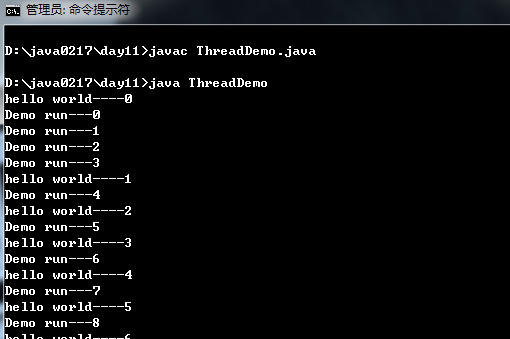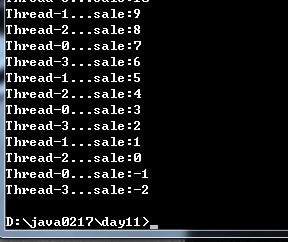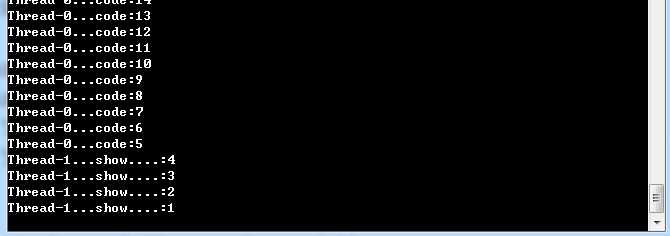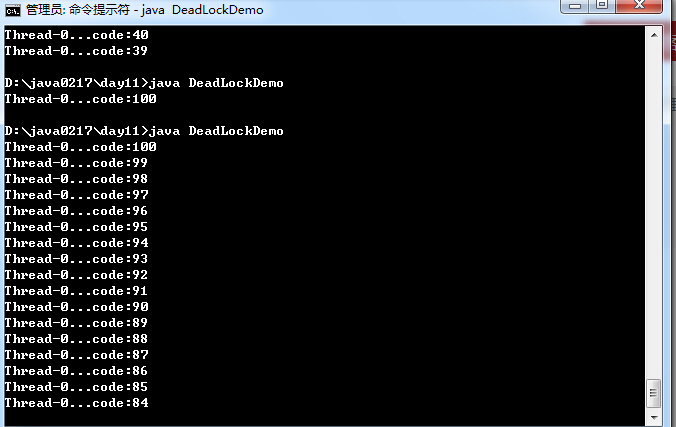多线程
进程:是一个正在执行的程序
每一个进程执行都有一个执行顺序,该顺序是一个执行路径,或者叫一个控制单元
线程:就是进程中的一个独立的控制单元
线程在控制着进程的执行
一个进程中至少有一个线程
如何自定义线程?
通过对API的查找,java已经提供了对线程这类事物的描述。就是Thread类
创建线程的第一种方式就是继承Thread类
1,定义类继承Thread
目的:将自定义的代码存储在run方法,让线程运行
2,复写Thread中的run方法
3,调用线程的start方法,
该方法有两个作用,启动线程,调用run方法
class Demo extends Thread
{
public void run()
{
for(int x = 0;x<60;x++)
System.out.println("Demo run---"+x);
}
}
class ThreadDemo
{
public static void main(String[] args)
{
Demo d = new Demo();//创建好一个线程
d.start(); //开启线程,并执行该线程的run方法
//d.run(); //仅仅是对象调用方法,而线程创建了没有运行
for(int x = 0;x<60;x++)
System.out.println("hello world----"+x);
}
}发现运行结果每一次都不同,
因为多个线程都获取CPU的执行权,CPU执行到谁,谁就运行。
明确一点:在某一刻,只能有一个程序在运行。(多核除外)
CPU在做着快速的切换,以达到看上去是同时执行的效果。
我们形象的看成多线程的运行在抢夺CPU的执行权
这就是多线程的一个特性,随机性。谁抢到就执行谁,至于执行多长,CPU说了算。
为什么要覆盖run方法呢
Thread类用于描述线程
该类就定义了一个功能用于存储线程要运行的代码。
该存储功能就是run方法
也就是说Thread类中的run方法,用于存储线程要运行的代码
练习
创建两个线程,和主线程交替运行
原来线程都有自己默认的名称
Thread-编号 该编号从0开始
static Thread currentThread();获取当前线程对象
getName() 获取线程名称
设置线程名称:setName或者构造函数
class Test extends Thread
{
Test(String name)
{
super(name);
}
public void run()
{
for(int x=0;x<60;x++)
{
//System.out.println(Thread.currentThread().getName()+"run..."+x);
System.out.println(this.getName()+"run..."+x);
}
}
}
class ThreadTest
{
public static void main(String[] args)
{
Test t1 = new Test("one");
Test t2 = new Test("two");
t1.start();
t2.start();
for(int x=0;x<60;x++)
{
System.out.println("main run----"+x);
}
}
}需求:简单的卖票程序
多个窗口同时卖票
创建多线程的第二种方式:实现Runnable接口
步骤:
1,定义类实现Runnable接口
2,覆盖Runnable接口中的run方法
将线程要运行的代码存放在该run方法中
3,通过Thread类建立线程对象
4,将Runnable接口中的子类对象作为实际参数传递给Thread类的构造函数
为什么要将Runnable接口的子类对象作为实际参数传递给Thread的构造函数
因为,自定义的run方法所属的对象是Runnable接口的子类对象
所以要让线程去指定对象的run方法,就必须明确该run方法所属的对象
5,调用Thread类的start方法开启线程并调用Runnable接口子类的run方法
class Ticket implements Runnable
{
private int tick = 100;
public void run()
{
while(true)
{
if(tick>0)
{
System.out.println(Thread.currentThread().getName()+"...sale:"+tick--);
}
}
}
}
class TicketDemo
{
public static void main(String[] args)
{
Ticket t = new Ticket();
Thread t1 = new Thread(t);//创建了一个线程
Thread t2 = new Thread(t);//创建了一个线程
Thread t3 = new Thread(t);//创建了一个线程
Thread t4 = new Thread(t);//创建了一个线程
t1.start();
t2.start();
t3.start();
t4.start();
}
}实现方式和继承方式有什么区别?
实现方式好处:避免了单继承的局限性
在定义线程时,建立使用实现方式
两种方式区别:
继承Thread:线程代码存放在Thread子类run方法中
实现Runnable,线程存放在接口的子类的run方法中
class Ticket implements Runnable
{
private int tick = 100;
public void run()
{
while(true)
{
if(tick>0)
{
try{Thread.sleep(10);}catch(Exception e){}
System.out.println(Thread.currentThread().getName()+"...sale:"+tick--);
}
}
}
}
class TicketDemo2
{
public static void main(String[] args)
{
Ticket t = new Ticket();
Thread t1 = new Thread(t);//创建了一个线程
Thread t2 = new Thread(t);//创建了一个线程
Thread t3 = new Thread(t);//创建了一个线程
Thread t4 = new Thread(t);//创建了一个线程
t1.start();
t2.start();
t3.start();
t4.start();
}
}通过分析,发现打印出了错票(0,-1,-2)
多线程的运行出现了安全问题
问题原因:
当多条语句在操作同一个线程共享数据时,一个线程对多条语句只执行了一部分
还没有执行完,另一条线程参与进来执行,导致共享数据的错误。
解决办法:
对多条操作共享数据的语句,只能让一个线程都执行完,在执行过程中,其他线程不可以参与执行
java对于多线程的安全问题提供了专业的解决方式
就是同步代码块
synchronized(对象)
{
需要被同步的代码
}
对象如同锁,持有锁的线程可以在同步中执行
没有持有锁的线程即使获得CPU的执行权,也进不去,因为没有获取锁
同步的前提:
1,必须要有两个或以上的线程
2,必须是多个线程使用同一个锁
必须保证同步中只能有一个线程在运行
好处:解决了多线程的安全问题
弊端:多个线程需要判断锁,较为消耗资源。
class Ticket implements Runnable
{
private int tick = 100;
Object obj = new Object();//synchornized需要对象
public void run()
{
while(true)
{
synchronized(obj)
{
if(tick>0)
{
//try{Thread.sleep(10);}catch(Exception e){}
System.out.println(Thread.currentThread().getName()+"...sale:"+tick--);
}
}
}
}
}
class TicketDemo2
{
public static void main(String[] args)
{
Ticket t = new Ticket();
Thread t1 = new Thread(t);//创建了一个线程
Thread t2 = new Thread(t);//创建了一个线程
Thread t3 = new Thread(t);//创建了一个线程
Thread t4 = new Thread(t);//创建了一个线程
t1.start();
t2.start();
t3.start();
t4.start();
}
}需求:
银行有一个金库
有两个储户分别存300,每次存一百,存三次
目的:该程序是否有安全问题,如果有,如何解决
如何找到问题?
1,明确哪些代码是多线程运行代码
2,明确共享数据
3,明确多线程运行代码中哪些语句是操作共享数据的
class Bank
{
private int sum;
//Object obj = new Object();
public synchronized void add(int n)//有了同步函数
{
//synchronized(obj)//不需要同步代码块
//{
sum = sum+n;
try{Thread.sleep(10);}catch(Exception e){}
System.out.println("sum="+sum);
//}
}
}
class Cus implements Runnable
{
private Bank b = new Bank();
public void run()
{
for(int x=0;x<3;x++)
{
b.add(100);
}
}
}
class BankDemo
{
public static void main(String[] args)
{
Cus c = new Cus();
Thread t1 = new Thread(c);
Thread t2 = new Thread(c);
t1.start();
t2.start();
}
}同步函数用的是哪一个锁?
函数需要被对象调用,那么函数都有一个所属对象引用。就是this
所以同步函数使用的锁是this
通过该程序进行验证
使用两个线程来卖票
一个线程在同步代码块中
一个线程在同步函数中
都在执行卖票动作
class Ticket implements Runnable
{
private int tick = 100;
Object obj = new Object();
boolean flag = true;
public void run()
{
if(flag)
{
while(true)
{
synchronized(this)
{
if(tick>0)
{
try{Thread.sleep(10);}catch(Exception e){}
System.out.println(Thread.currentThread().getName()+"...code:"+tick--);
}
}
}
}
else
while(true)
show();
}
public synchronized void show()//this
{
if(tick>0)
{
try{Thread.sleep(10);}catch(Exception e){}
System.out.println(Thread.currentThread().getName()+"...show....:"+tick--);
}
}
}
class ThisLockDemo
{
public static void main(String[] args)
{
Ticket t = new Ticket();
Thread t1 = new Thread(t);
Thread t2 = new Thread(t);
t1.start();
try{Thread.sleep(10);}catch(Exception e){}
t.flag = false;
t2.start();
}
}如果同步函数被静态修饰后,使用的锁是什么?
通过验证,发现不再是this。因为静态方法中也不可以定义this
静态进内存时,内存中没有本类对象,但是一定有该类对应的字节码文件对象
类名.class 该对象的类型是class
静态的同步方法,使用的那个锁是该方法所在类的字节码文件对象。类名.class
class Ticket implements Runnable
{
private static int tick = 100;
boolean flag = true;
public void run()
{
if(flag)
{
while(true)
{
synchronized(Ticket.class)
{
if(tick>0)
{
try{Thread.sleep(10);}catch(Exception e){}
System.out.println(Thread.currentThread().getName()+"...code:"+tick--);
}
}
}
}
else
while(true)
show();
}
public static synchronized void show()//this
{
if(tick>0)
{
try{Thread.sleep(10);}catch(Exception e){}
System.out.println(Thread.currentThread().getName()+"...show....:"+tick--);
}
}
}
class StaticMethodDemo
{
public static void main(String[] args)
{
Ticket t = new Ticket();
Thread t1 = new Thread(t);
Thread t2 = new Thread(t);
t1.start();
try{Thread.sleep(10);}catch(Exception e){}
t.flag = false;
t2.start();
}
}单例设计模式
饿汉式
class Single
{
private static final Single s = new Single();
//加了一个final
private Single(){}
public static Single getInstance()
{
return s;
}
class SingleDemo
{
public static void main(String[] args)
{
}
}懒汉式
class Single
{
private static Single s = null;
private Single(){}
public static Single getInstance()
{
if(s==null)//减少锁的判断的次数
{
synchronized(Single.class)
{
if(s==null)
s = new Single();
}
}
return s;
}
}
class SingleDemo
{
public static void main(String[] args)
{
}
}死锁
死锁
同步中嵌套同步
class Ticket implements Runnable
{
private int tick = 100;
Object obj = new Object();
boolean flag = true;
public void run()
{
if(flag)
{
while(true)
{
synchronized(obj)
{
show();
}
}
}
else
while(true)
show();
}
public synchronized void show()//this
{
synchronized(obj)
{
if(tick>0)
{
try{Thread.sleep(10);}catch(Exception e){}
System.out.println(Thread.currentThread().getName()+"...code:"+tick--);
}
}
}
}
class DeadLockDemo
{
public static void main(String[] args)
{
Ticket t = new Ticket();
Thread t1 = new Thread(t);//创建了一个线程
Thread t2 = new Thread(t);//创建了一个线程
t1.start();
try{Thread.sleep(10);}catch(Exception e){}
t.flag = false;
t2.start();
}
}实际开发中要避免死锁。


























 1586
1586

 被折叠的 条评论
为什么被折叠?
被折叠的 条评论
为什么被折叠?








